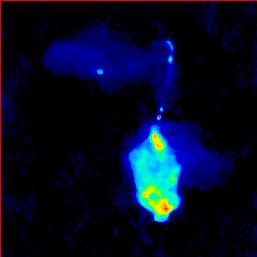 Image:
Image:3C 433 | B2121+248 |
| S178 | Alpha | FR | Class | ID | Spectrum | Best z | mag. | LAS | lg P178 | D |
|---|---|---|---|---|---|---|---|---|---|---|
| 61.3 | 0.75 | I | SB+HP | Gal | 0.1016 | V = 15.98 | 68.60 | 25.99 | 114.0 |
| Size: | 80.2 × 80.2 arcsec² |
|---|---|
| LUT: | Linear |
| Beam: | 0.75 arcsec |
| Frequency: | 8350 MHz |
| Method: | VTESS Õ˜ÿ>0.75
|
| Telescope: | VLA A+B+C |
| Credits: | Black et al. (1992) |
The host galaxy is a member of a close pair, often classified as a dumbell galaxy (e.g. Colina & Perez-Fournon 1990). The locations of both galaxies are shown by green crosses in the picture. There is a radio-optical overlay (and another rendering of the radio image) in Alan Bridle's image gallery.
The HST image of de Koff et al. (1996) shows complex central structure which they attribute to dust and possible star formation. HI absorption against the radio source was detected by Mirabel (1989); although the integrated optical depth is low (0.005), only a small fraction of the radio emission is close enough to the galaxy to act as a background source, implying that substantial absorption must take place near the centre. The HI shows a narrow feature with broad (700 km/s) wings. Baum et al. (1988) detected an extended emission-line nebula in the host, and a long-slit spectrum (Baum et al. 1990) showed complex kinematics, with a total velocity range similar to that seen in HI.
Although the nuclear spectrum is typical of narrow-line galaxies, the near- and far-infrared colours are non-stellar (Lilly, Longair & Miller 1985, Yates & Longair 1989); the SED peaks at around 25 microns. 3C 433 also has a relatively high X-ray luminosity (Fabbiano et al. 1984); all these suggest that there is a powerful AGN in the galaxy that is obscured in the optical.
The environment is sometimes described as a cluster, but it would be more accurate to say that the dumbell and a few much smaller galaxies make up a small group; consistent with this there is little Faraday depolarization.
The high resolution images of Black et al. (1992) show that there are two compact components at the base of the jet, separated by about 0.5 arcsec. The optical astrometry is not good enough to determine which is coincident with the galaxy centre, but most likely it is the slightly brighter southern component, so that the jet is fully one-sided.
Neither of the very asymmetric lobes closely resembles any other in our sample. The good collimation and knotty structure of the jet in the northern lobe are typical strong-flavour, but the magnetic field is often diagonal to the jet axis. The jet's second quarter is invisible. Diffuse emission surrounds its path, and near the end trails off to the east to form the northern lobe. Distinct ridges emanate from the jet's brightest knot and from the very end of the jet. There is a fairly compact hotspot near the centre of the northern lobe, slightly fainter than the peak of the jet. There is no obvious connection between jet and hotspot and it is not clear what is keeping the hotspot compact.
The southern lobe is much brighter, although faint emission trails
off to the west at about the same brightness level as the northern lobe,
suggesting an X-type structure. The main part of the southern lobe
is a plateau of roughly constant brightness, albeit with a lot of
low-contrast structure; this suggests that in 3-D the structure must
be significantly edge-brightened. The lobe has two bright peaks, close
to the outer and inner edges respectively. At low resolution the outer
peak is brighter, putting 3C 433 in the FR II class, consistent with its
luminosity. On the other hand the inner peak contains a compact peak
well aligned across the core with the jet; this is the brightest point
at high resolution, and gives this lobe its "plume" classification.
Just as with the tip of the northern jet, there
are ridges in the lobe surrounding this peak which give the impression
that the compact structure is rotating clockwise, leaving a sort of
wake behind.
| Prev. | Data Page | Other images | Next | Search | Alphanumeric List | Icon List | Atlas Index |
|---|